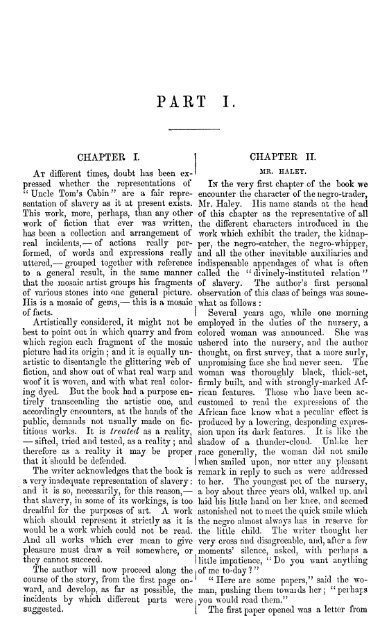UNCLE TOM'S CABIN
1iw97FV
1iw97FV
- No tags were found...
Create successful ePaper yourself
Turn your PDF publications into a flip-book with our unique Google optimized e-Paper software.
"<br />
thisis<br />
PART<br />
I<br />
CHAPTER I.<br />
CHAPTER<br />
II.<br />
At differenttimes,doubt has been expressed<br />
whether the representations of<br />
"<br />
"<br />
In the very<br />
firstchapter of the book we<br />
"Uncle Tom's Cabin" are a fair representation<br />
encounter the characterof the negro-trader,<br />
of slaveryas it at present exists. Mr. Haley. His name stands at the head<br />
This work,more, perhaps țhan any other of this chapteras the representative of all<br />
work of fiction that ever was written, the different characters introduced in the<br />
has been a collection and arrangement of work which exhibit the traderțhe kidnapper,<br />
real incidents, of actions reallyperformed,<br />
the negro-catcher, the negro-whipper,<br />
of words and expressions reallyand<br />
all the other inevitable auxiliariesand<br />
uttered, groupedtogether with reference indispensable appendages of Avhat is often<br />
to a generalresult, in the same manner called the " divinely-instituted relation "<br />
that the mosaic artist groups his fragmentsof slavery.The author's first personal<br />
of various stones into one generalpicture. observationof thisclassof beingswas somewhat<br />
His is a mosaic of gems,<br />
a mosaic<br />
a3 follows :<br />
of facts.<br />
Several years ago, while one morning<br />
Artistically considered, it might not be employed in the duties of the nursery, a<br />
best to point out in which quarry<br />
and from colored woman was announced. She was<br />
which regioneach fragment of the mosaic ushered into the nursery,<br />
and the author<br />
picture had its origin; and it is equallyunartisticto<br />
thought, on first survey, that a more surly,<br />
disentangle the glittering web of unpromising face she had never seen. The<br />
fiction, and show out of what real warp and woman was thoroughlyblack,thick-set,<br />
woof it is woven, and with what real coloring<br />
dyed. But the book had a<br />
purpose entirely<br />
the artistic one, and<br />
; and<br />
therefore as a realityit may be proper<br />
that it should be defended.<br />
The<br />
thatthe book is<br />
when smiled upon,<br />
nor utter any pleasant<br />
writer acknowledges<br />
remark in replyto such as were addressed<br />
a<br />
very inadequate representation of slavery : to her. The youngestpet of the nursery,<br />
and it is so, necessarily, for this reason," a boy about three years old,walked up, and<br />
that slavery, in some<br />
of itsworkings, is too<br />
pleasuremust draw a veil somewhere,or<br />
theycannot succeed.<br />
The author will now proceedalongthe<br />
course of the story, from the first page onward,<br />
and develop, as far as possible, the<br />
incidents by which different parts were<br />
suggested.<br />
MR.<br />
HALEY.<br />
firmlybuilt,and with strongly-marked African<br />
transcending<br />
to read the expressions of<br />
accordingly encounters, at the hands of the<br />
public,demands not usually made on fictitious<br />
producedby a lowering, desponding<br />
works. It is treated as a reality, upon<br />
"<br />
sifted, triedand tested, as a reality<br />
race generally, the woman did not smile<br />
African face know what a peculiar effectis<br />
features. Those who have been accustomed<br />
the<br />
expression<br />
its dark features. It is like the<br />
shadow of a thunder-cloud. Unlike her<br />
laid his littlehand on her knee,and seemed<br />
dreadful for the purposes of art. A work astonished not to meet the quicksmile which<br />
which should represent it strictly as it is<br />
would be a work which could not be read. the little child. The writer thoughther<br />
And all works which ever mean to givevery cross and disagreeable, and,after a few<br />
moments' silence,asked, with perhaps a<br />
the negro almost alwayshas in reserve for<br />
littleimpatience, "Do<br />
you want anything<br />
of me to-day? "<br />
"<br />
Here are some papers," said the woman,<br />
pushing them towaids her; "perhaps<br />
you would read them."<br />
The first paper openedwas a letterfrom




